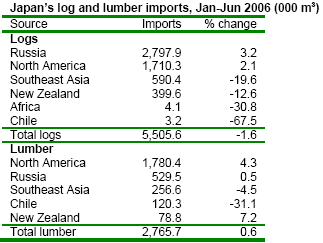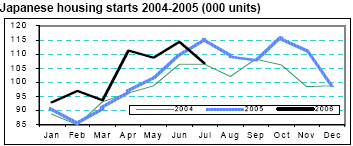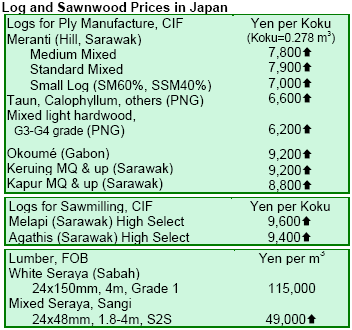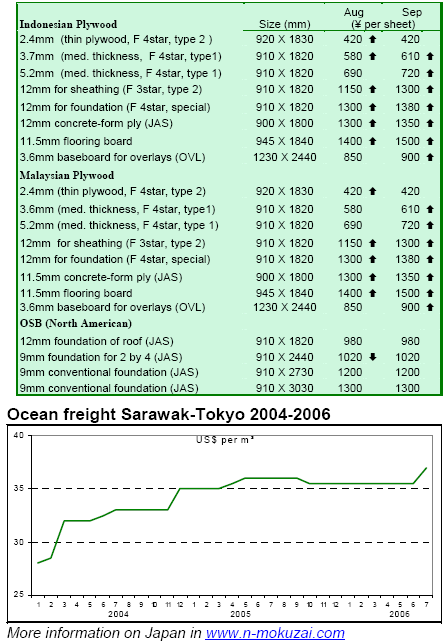|
Japan
Wood Products Prices
Dollar
Exchange Rates of 13th Sep. 2006
Japan
Yen 117.66
Reports
From Japan
Lumber imports rise as log imports falter
Japan’s import of logs fell almost 7% to 5.5 million m3 in the first half of 2006 due mainly to reductions in imports
from Southeast Asia, Africa and New Zealand. Lumber imports rose slightly to 2.77 million m3 as supply from
North America and Russia offset shrinking imports of tropical lumber. Meanwhile, the import unit cost from all
sources continued to rise.
Tropical logs accounted for 11% of Japan’s total log imports, down from 13% in 2005. New Zealand log export
prices remained high because of considerable appreciation of New Zealand dollar against the US dollar and increased
demand from China, Korea and South East Asian
countries. Southeast Asian log supply tightened further as control of illegal logging continued to be enforced.

Imports of European lumber expanded 5.4% to 1.51 million m3 despite the sharp appreciation of the euro
against the yen. Since there was no immediate substitute for this product, Japanese structural laminated lumber
manufacturers were aggressively buying European lamina. Imports of structural laminated lumber also remained
active, rising 16.5% to 380,037 m3.
Sumisho & Mitsuibussan in plywood joint venture
Sumisho & Mutsuibussan Kenzai Co., Ltd. has established a KD veneer manufacturing company jointly with
Sarawak’s Ta Ann Plywood and Forestry Tasmania. Under the deal, Ta Ann Plywood will process eucalyptus
veneer mainly into floor base plywood at its Malaysian
plant. Since prices for Southeast Asian hardwood floor base panel have soared, Japanese building materials
companies were seeking substitutes such as eucalyptus.
The joint venture involves 24 million Australian dollars ($18 million), with Ta Ann Plywood investing 75%,
Sumisho & Mitsuibussan 15% and Forestry Tasmania 10%. The companies plan to manufacture 70,000 m3 of
3x6 KD veneer out of 150,000 m3 of eucalyptus logs a year. The veneer would be subsequently shipped to Ta
Ann Plywood in Malaysia for the manufacturing of about 60,000 m3 of floor base panel a year, mainly 9-12mm 3x6.
Forestry Tasmania has guaranteed log supply for the next 20 years. The plant is scheduled to be completed in
January and operate in March 2007.
Japan suffers setback in new housing starts
Total housing starts fell to 106,649 units in July, down 7.5% from a year ago and the first decline in six months.
Wood-based units accounted for 46% of the total housing starts, up from 45% last month. Seasonally adjusted
annual starts reached 1.21 million units, the lowest level
this year.

The Research Institute of Construction and Economy
(RICE) raised its 2006’s new housing starts estimate to 1,255,000 units, up 1.1% from April’s estimate. RICE
expects owner’s units to bottom out and keep gradually rising with rental and units built for sale remaining at last
year’s levels. RICE’s new forecast for 2007 housing starts was 1,260,000 units.
Noda reduces consumption of tropical plywood
Japan’s Noda Corporation has again raised its sales prices of hybrid floor products in late August to cope with short
supply and high prices of Southeast Asian plywood. Noda has also informed that it will be using compound softwood
baseboard for standard products to reduce dependency on Southeast Asian hardwood plywood.
With a floor production of about 660,000 m2 a month, the share of softwood compound floor could increase to 30%
of Noda’s total floor production. According to Noda, prices for softwood compound materials such as plywood
and MDF are much more stable compared with Southeast Asian products.


|